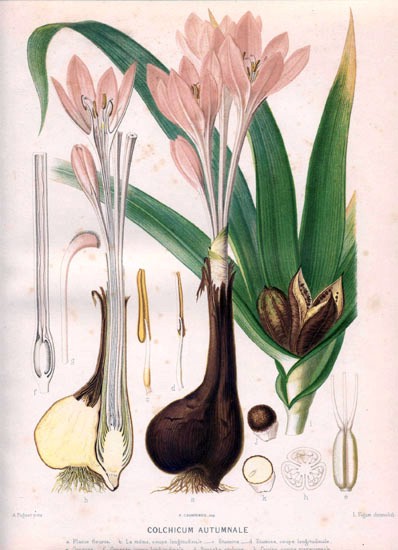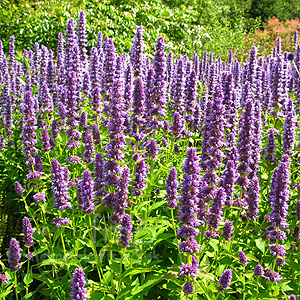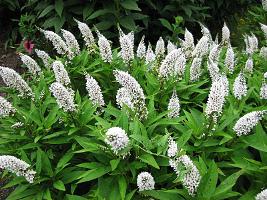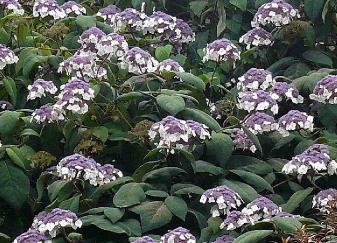Newsletter
Autumn 2013
No. 38

taken from Dictionnaire de botanique by Henri Ernest Baillon and others, volume 3, published in 1891
Newsletter |
 Colchicum autumnale taken from Dictionnaire de botanique by Henri Ernest Baillon and others, volume 3, published in 1891 |
Please remember that as from January 2014 our monthly meetings will be held at Crowle Parish Hall, Church Road, Crowle WR7 4AZ
What a year we have had! A cold wet spring when we despaired of anything getting going and then – warmth and sunshine and our gardens sprang into life! Suddenly I had seedlings germinating everywhere and the greenhouse was full to bursting. We had a week’s holiday in Majorca and came home to similar temperatures here with everything growing like mad in the garden. Even after only a week away plants seemed to have doubled in size and I must thank my neighbours for their help in keeping them watered.
Mid-June saw us on the HPS trip to Cumbria where once again we were not disappointed. We saw some fabulous gardens and were so envious of the way that meconopsis grew like weeds in them. If you haven't already, take a look at the photos on our website to see what I mean. David Pollitt is to be congratulated yet again for another superbly organised trip with a wide range of gardens and a good hotel. He even arranged for the weather to be dry and warm!
Our second plant fair in June proved to be another success and I must thank all those who donated plants and helped out. We hope this will become a permanent fixture and that people will associate us with a good range of plants at keen prices.

Did anyone else see the sculpture exhibition in the gardens at Coughton Court? We found it very interesting with so many on show – I believe that there were over 300 exhibits on sale. Needless to say, we unerringly picked out the most expensive as the ones we would like. Looking at the gardens themselves it was interesting to see how good the hot border was looking. Red seems to be a good colour for late summer with dahlias, monardas, heleniums and crocosmias looking their best.
I understand that this has been a good year for bees. My younger daughter pointed out the large numbers on the agastache and purple toadflax in our front garden – mostly carder bees. I have been a bit sneery about toadflax as it seeds everywhere but it is such a good bee plant and can easily be pulled up if needs be. However, how many ladybirds have you seen? So far, just a few including a harlequin in my garden and that seems to be universal this year. My sarracenias have also done really well and are chock full of insects, so much so that some have managed to escape by clambering on the others’ shoulders (if insects have shoulders) to get out of the pitchers.
Now, a tale of success after failure! I was heartily sick of people assuring me that Verbena bonariensis seeded everywhere in their garden when all it did was die in mine over winter. However, a friend dug up a large piece from her daughter's garden for me last year, it survived, flowered (and is still flowering) and has seeded as well.
Today is autumnal and grey which makes me think of starting to get the garden ready for winter, but if the sun comes out I'll banish that thought for the time being.
Happy gardening,
With the onset of autumn I hope you will enjoy this edition of the Newsletter and be transported back to the sunny days of summer when reading the reports on our trip to Cumbria back in June, and many thanks to all those members who kindly agreed to write up a report. I thoroughly enjoyed the trip and will always remember the wonderful meconopsis and primulas seen in their prime at several of the gardens - as well as all the tea and cakes! My favourite garden was Greencroft House which literally just made me say ‘Wow’.
Marilyn would also like to pass on her thanks to all those members who took the trouble to vote for their favourite talks from the list she produced at the last meeting.
As ever, please keep your contributions coming; the copy deadline for the next issue is the February 2014 meeting.
Subscriptions to the Group become due on 1st January 2014. A standing order mandate is included with this Newsletter to be returned to me by 20 December 2013. Alternatively, subscriptions can be paid either on the door at a meeting or by post to my address at Half Acre, Main Street, Worcestershire, WR11 7XB. Cheques to be made payable to ‘HPS Worc's Group’. The sub remains the same at £12.50 and admission to the meetings is free. It would be helpful if you are able to give me a post-dated cheque at our December 2013 meeting. This would ease the burden on the door in January 2014. Remember membership of the Group is conditional on being a member of the national Hardy Plant Society.
I would like to let you all know that I am now the co-ordinator for Worcestershire Group.
Currently, nearly twenty of us are growing conservation plants, but I cannot over emphasise that this an activity open to all members, not an exclusive clique for experts. If it was, I don’t think I would qualify! To find out more about what is involved take a look at the HPS website, pick up a leaflet at a Group meeting or contact me (See contacts page).
I came to my first Group meeting nearly ten years ago and during that time my predecessor, Jackie Davies, has always been ‘doing something’ for us. She did a long stint as Newsletter Editor before taking on the Conservation Scheme role, and going way back she was one of the founding Committee Members. So I hope Jackie will continue to enjoy our activities as an ‘ordinary’ member, she certainly deserves it.
Coffee mornings for next year have been arranged as follows:
There will also be an evening garden party (take a plate of food) at 7.00pm on Friday 25 July hosted by John & Lesley Bryant, Stoulton.
Details of the gardens and directions will be in the Spring 2014 Newsletter.
Nearly everyone has a favourite flowering plant. For the majority it is the rose, and yet a glance at a list of specialist groups and societies would seem to indicate that every genus of plant has it devotees, even the strange carnivorous plants have their supporters. Most well-known of the groups, thanks to coverage by the media early in the year, are the galanthophiles, enthused by variations in the markings on a small white flower.
For us, our favourite is the clematis. How this came about I cannot recall, but it goes back well over 20 years, and is due to a gradual, but sustained, appreciation of the merits of the genus, rather than a dramatic ‘Damascene’ conversion.
Why clematis? Well just consider: they can be deciduous or evergreen; climbing or non-climbing; just a foot tall or reaching up to 20 feet; the flowers can be single or double, in a variety of colours and differing shapes; the leaves can be simple or lobed, and, with careful selection, you can have one in flower every month of the year. Within the border they take up little space as the growth is vertical rather than horizontal. I doubt if there is any other genus, even roses, that can match the above for a plant’s CV.
On occasion, fellow gardens have said to me “I like clematis but I can’t grow them as they always seem to die on me”. We all lose plants from time to time, for a variety of reasons, but that shouldn’t preclude us from trying again. I suspect that the clematis losses are due to a lack of understanding of the conditions and requirements for growing them successfully. At the risk of telling you what you already know, but also based on personal experience, these are:-
Selection of plant – Look for a good healthy plant with multiple stems rather than a single stem, even though covered in blooms. If the roots are in evidence through the bottom of the pot, this is a good sign. Should you fall for offers of three for £10, rooted cuttings known as liners, at the Malvern Show or a similar plant fair, be advised that, contrary to what the salesman will tell you, these are not ready for planting out. There is nothing wrong with them but they need potting on and growing in a controlled situation before they are robust enough to cope with the competitive world of the garden. This is usually between six months and a year from purchase.
Planting – Clematis are not over-fussy about aspect, although they won’t grow in deep shade or in a windy, dry, exposed situation. As regards the actual planting there are two proponents of this, namely, the deep planters, as espoused by Monty Don, and the soil level planters. The argument for deep planting is to allow for regeneration, should wilt kill all the top growth. Interestingly, at a Clematis Society meeting a year or two back now, the speaker asked those attending, about 40 in number, whether they planted deeply or at soil level, and all replied ‘at soil level’. Both camps agree that a substantial hole should be dug and well rotted compost, together with a generous handful of bonemeal, be placed beneath and around the clematis to give it a good start in life. After this a really good drink of water is needed. I plant a little below soil level so that the water will go where it is needed, rather than run off at the sides. If possible, plant the clematis where the root area is shaded by other plants. Failing this apply a good thick coarse mulch to the area. Large stones are not recommended as they provide a hiding place for slugs and snails.
After care – In its first year, regular watering is essential, particularly during dry periods. A plant should never be allowed to dry out completely as this can prove fatal. Here, it should perhaps be stated, that clematis are not low maintenance plants. Pruning is not nearly as complicated as many people think. To make sure you get it right, keep the label, or better still make your own, with the group number writ large. The first to flower, the atragenes and the montanas in Group 1 don’t need pruning, just an occasional tidy up, whilst the early large flowered hybrids only require a light trim immediately after flowering. The third group comprising the viticellas, viornas, texensis and the late large flowered hybrids should be cut down to about nine inches from the ground in February, although I tend to remove the majority of their considerable top growth in November, otherwise they look unsightly throughout the winter. The herbaceous varieties can be treated like any other perennial and cut to the ground in autumn. I apply feed twice in the year: bonemeal, scattered around in the early winter, and then fish, blood and bone at the beginning of spring. On both occasions I mulch around liberally with organic matter. Recently I have taken to using the treated farmyard manure sold in bags at the local garden centre. In spring, as the days warm up and lengthen, clematis can put on a very rapid spurt of growth, and for some of them it is necessary to give them a helping hand to attach themselves to a trellis, obelisk or other form of support by tying them in, otherwise they will sprawl all over the place. At this stage some judicious pinching out of the growing tips, particularly with the group threes, will help them bush out. A little patience is required as the majority of clematis plants take about three years to settle in from first plants and to start flowering profusely.
With regard to pests and disease, Phoma Clematidina, a fungal disease specific to the genus and more commonly known as wilt, is the main enemy. It attacks the stems at ground level causing total collapse, seemingly overnight, and for which there is no treatment at present. Fortunately, it is largely confined to the Group 2 varieties. The growers are constantly trying to breed new varieties resistant to it. Mildew is sometimes a disfiguring nuisance on texensis and viorna varieties, but early spraying of a fungicide can alleviate the problem, otherwise, apart from the depredations to young shoots of the all too familiar slugs and snails, clematis are a reasonably healthy genus.
I must admit that clematis can sometimes be frustratingly perverse in their behaviour, but this should not put you off growing them. In full flower it is a plant of eye-catching beauty and every garden should have at least six. And, oh yes, I nearly forgot, they can live for up to 50 years, which, with respect, should see most of us out!
Mine grows best in the spring and is quite colourful until the end of June. After that, and especially with the dry summer we’ve had this year (I don’t water), there is not much of interest. So I decided to go out and about during August to look at other gardens to see what strategies I could employ for extending the season in mine. I visited a number of gardens, large and small, those that are open regularly as well as some opening for the National Gardens Scheme. It was a lovely way to spend a few summer afternoons, but what did I learn?


Well, it seems there are two varieties of gardener. One rejoices in the ‘hot border’, grouping all those bright yellows, reds and oranges, often using a backdrop of dark purple foliage, to produce the ‘wow’ factor. The other allows the garden to settle into late summer maturity, but has a scattering of ‘feature plants’ among the earlier flowering perennials and shrubs that often produce a second smaller flush of flower if meticulously dead-headed.
My garden does not immediately lend itself to the creation of a hot border, as most of the borders are part-shaded by old fruit trees. However, I resolved to learn to love some of the South African plants such as kniphophia and crocosmia for sunnier spots, not perhaps in fiery red, but in some of their newer colour forms of yellow and apricot. Many autumn flowering perennials have daisy flowers and I last year I added Helianthus ‘Lemon Queen’, Helenium ‘Sahin’s Early Flowerer’ and a couple of Michaelmas daisies. Lysimachia clethroides has survived for many years in spite of my dry stony soil and flowers in autumn with spikes of tiny white flowers in the shape of a shepherd’s crook.
There are a few good autumn flowering shrubs; Abelia grandiflora provides a focus by the back gate at this time of year and is covered in flower (and bees) at the moment. Another shrub which caught my eye in several gardens is Hydrangea aspera. This has dull green leaves but the flowers are large pale mauve and white lacecaps. The pollen is blue so bees visiting the flowers look sweet with little blue pollen sacs. I have also just planted a Caryopterisx clandonensis at the sunny end of a border to attract bees and butterflies.
As for the fruit trees, ten apples and three pears are overwhelming me and my garden. I dread the deluge of fruit (although left on the ground it feeds the wildlife until well into winter) and I’m tired of being unable to walk across the garden unless bent double like Quasimodo! So this winter will see some radical pruning and I hope will result in a sunnier, more vibrant garden through next summer into autumn.
Growing to a ripe old age: 50 years in the garden by Edward Enfield (library shelfmark: 635)
This may bring a few amusing memories to read as we go through these autumn days and maybe a little something to smile about.